Mary’s Childhood: From Nazareth to the Presentation in the Temple
The Blessed Virgin Mary took great strides in holiness and grace, even in her earliest years – preparing her for her role as the Mother of God and Our Lord’s closest disciple.
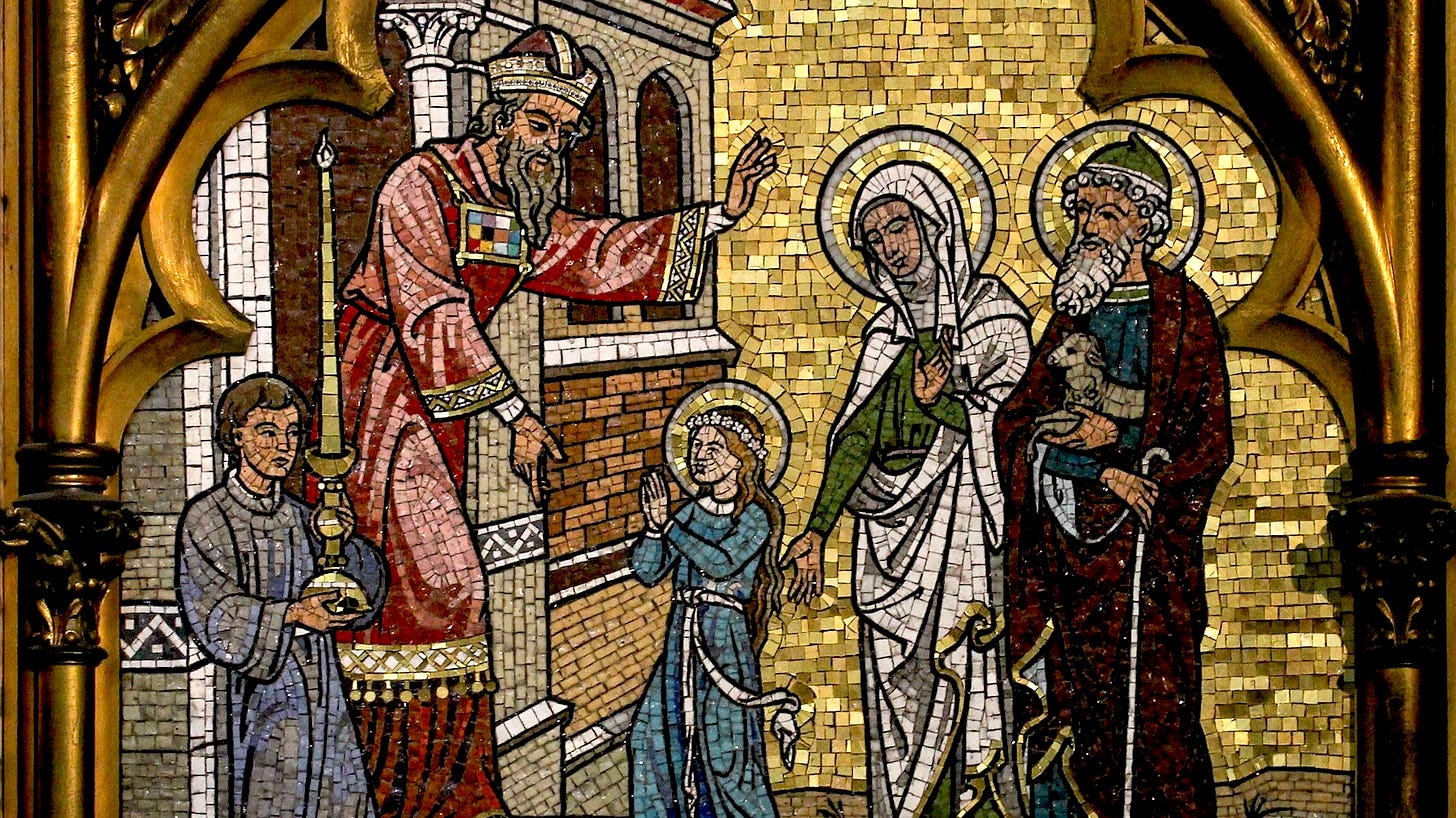
Following the feast of the Nativity of Our Lady last week, here is a follow-up for the Holy Name of Mary.
The Childhood of Our Blessed Lady
From
Mother of the King – Mary During the Life of Our Lord
Fr Henry James Coleridge, 1886, Ch. V, pp 43-50
Early manifestations of character
We all know that the character of children is manifested at the earliest age to those who study them and live with them, who catch a thousand little traits which would escape the notice of others.
It is one of the delights of the young mother to watch this unfolding of character in her child. It becomes a greater delight in proportion as she is more tenderly devoted to the babe, has higher hopes and aspirations for him, and discerns, or seems to discern, the traces of resemblance to his father or some other near relative to whom she is deeply attached.
If any child might have been expected to display to this loving motherly gaze the traits of character from the very beginning, it would naturally be one like St. John [the Baptist], or our Blessed Lady herself, in whom, by a special grace of God, the use of perfect reason and choice had been anticipated in earliest infancy, in whom therefore there was maturity of intelligence and perfect consciousness of the relations in which he or she was placed to God and to man.
We have here something at least to guide us in our thoughts concerning the character of our Blessed Lady as it might thus have revealed itself to St. Anne and St. Joachim.
Effect of grace in Mary
In the first place, whether St. Anne was conscious or not of the special graces bestowed upon Mary in her birth, we cannot doubt that the simple existence of those graces must have made her, not indeed unlike any other child in the manifestation of intelligence by speech or in any other way which would have made her infancy prodigious, but free from the pettinesses of temper, the waywardnesses of caprice, the silly freaks and wilfulnesses which have to be borne with in the majority of ordinary children.
There are saints of whom we read wonderful things about their early fondness for mortifications and self-denials. This fondness cannot have been in them the fruit of any abiding elevation above the usual state of infant intelligence or choice, but rather of occasional impulses which may have been vouchsafed to them for particular purposes of God.
Marvellous indeed is the mystery of the state of infancy, even in its ordinary condition. But the condition of Mary as an infant was not ordinary. She must have been a child full of holy joy and happiness, of love and charity, a child of calm and peaceful gravity and an angelic playfulness, of purity and meekness and tenderness to her mother beyond her age, as people might have said. This must have been the impression she may have given to those who saw her externally. Interiorly, we must believe that her soul was full of beauties known only to God, and that her mind and affections were continually at work for Him.
As St. Anne had borne her since her Conception with so little of the ordinary burdensomeness of children, so Mary grew on in the first weeks and months of her life as one might be expected to grow in whom there were none of the penalties of original sin to be found, and whose mind and heart were already opened to the constant showers of Divine grace, producing there, as in a most fertile soil, the perpetual harvest of holy aspirations and prayers.
We see sometimes among Christian families children who seem to have no trace of what we may call natural malice in them, but on the contrary to be always moved by holy impulses, as we should certainly deem them if they were of riper age. Such children may remind us faintly of what St. Anne may have seen in her own.
Her character moulded thereby
Again, it is usual for the characteristics of the parents to show themselves in the children even from the beginning, though this rule is not of invariable application. It is the same with the lineaments of the face as with the more subtle features of the mind and heart.
It is well enough to suppose that the mother of our Blessed Lady might have often rejoiced to observe that her child, the child of so many prayers, bore some resemblance to her own features, as afterwards it is thought that the features of our Lord gave back a perfect resemblance to those of His own Blessed Mother.
But in the case of the character of Mary we may more reasonably presume that it was the character of Jesus which was as it were anticipated in her, rather than her character repeated in Him. The character of one who had the privilege which we suppose our Lady to have possessed, of being able to converse interiorly with God from the first by the perfect use of her intelligence and will, must have been very greatly moulded by the use of this privilege.
It was the centre and heart of her whole life and being, and there could have been no thought or action of hers which did not at least to the eye of Heaven reflect its influence.
The mysteries of Redemption
But it was inevitable, both from the nature of the case and from the special vocation of our Lady in the Kingdom of her Son, that her thoughts must have been led principally, and by a special attraction, to the great attributes of God manifested in that greatest of His works, in which she was to bear so large a part and for which she had been called into the world, the work of the redemption and glorification of mankind by means of the Incarnation and Passion.
She was not conscious of her vocation, but He Who fashioned her soul for this great work knew it beforehand, and prepared her for it from the beginning.
We often see in ordinary children traits of character and taste which interpret themselves in after years, when they come to take their place in life. So it is reasonable to think that Mary's soul and heart flew by a congenital attraction to the mysteries of Redemption.
This would make the interior acts of her will and intelligence as like as was possible to those of her Divine Son, when He dwelt so long in her womb, and thus the heart and mind of the Mother were formed and fed on the same contemplations and aspirations which occupied His own soul during the nine months. It cannot be wondered at if the character thus formed in her was shaped after the fashion of that of her Divine Son.
We can trace in the very few notices which remain to us on this subject a great resemblance between our Lord's special characteristics and those of our Blessed Lady, as for instance her extreme mercifulness, as shown in the marriage feast, which exactly resembles His anxiety lest the crowds should go home without food on the occasion of the great miracles of the loaves, and one or two other such occasions.
But in truth we cannot prove this better than by the reasons which we have for taking it for granted that so it must have been.
Presentation in the Temple
Mention has been made of the feast of the Presentation of our Blessed Lady in the Temple. This gives liturgical sanction to the old tradition which represents her as taken to the sanctuary by her parents at the age of three years, in order that she might be brought up in the little society of girls who were trained in a kind of religious manner under the shadow of the sanctuary itself.
It has been said elsewhere that there can be nothing unreasonable in this tradition in itself.1 Nor can it be supposed a strange thing that St. Joachim and St. Anne should be willing thus to provide for the education of their child at a distance from their own home, which seems to have been fixed at Nazareth.
If St. Anne looked with any peculiar devotion to her famous namesake, the mother of the Prophet Samuel—whose canticle is used by our Blessed Lady in her own Magnificat in a manner which suggests the thought of its being a household song of thanksgiving in her family—she would find there an exact precedent for the course which she is said to have taken in thus disposing of her own child.
There may moreover have been special reasons in the case of the parents of our Lady for this course, and they are supposed in the legend to have vowed to the service of God the child for whom they prayed so fervently, as was the case with Samuel.
It was her natural home
But the truth which we have made the foundation of these considerations concerning Mary furnishes us with a further reason for the Presentation in the Temple, and the life of the child which followed on that Presentation.
For if her mind and heart were to occupy themselves perfectly and continuously upon God and Divine things, and especially the mysteries of the Incarnation, it would be a most natural security for this great end that she should be placed under circumstances most fitted for the exercise of her powers, in such a way as should give the greatest glory to God and enable her to make the most rapid progress in the path of sanctification.
But for this object there could be no better home for Mary than the sacred retreat of the sanctuary, where she would live among the praises and worship of God, close to the most sacred spot on earth, and be a constant attendant on the sacred services and sacrifices instituted for the especial purpose, among others, of preparing the minds of the people for the execution of the designs of God in the Incarnation.
No doubt her soul might make much progress in the way of God in the quiet holy home of St. Joachim and St. Anne. But still there would be a calm peace, an unruffled security, an opportunity of the exercise of prayer and worship, in the Temple, which would not be found elsewhere.
If our Lady had the privilege which we believe her to have had, it must have been, not an idle boon or a faculty conferred merely to do her honour, that she might not be lacking in any gift which was bestowed on others. It must have been given her for use and for the especial purpose, as has been said, of her more speedy and singular exaltation in the measures of grace.
And for this, the residence in the Temple would be the most convenient and efficacious disposition.
Probability of the fact
It has been said that the truths which thus flow from what we may fairly believe concerning the interior graces bestowed upon our Blessed Lady are more important to us than the external facts of her history.
There is every reason for thinking that the devout children of the Church have a perfect right to their belief as to the Presentation of our Lady in the Temple after she had been weaned by St. Anne at the age of three years.
But even if this should be thought to lack sufficient authority, on account of the date of the legend in which the facts are embodied, it would only follow that we should not be sure of the place in which those years of her life were spent. But the truth of her continual progress in the use of her graces already received, and in the reception of fresh graces from the hand of God, whether in reward for her faithfulness or as given by His simple bountifulness for the sake of her Son, would not be in any way affected by the doubt that might be thrown on the history of her sojourn in the sanctuary.
Wherever the early years of her life were spent, she was still the chosen Virgin whom we understand to have been conceived without the stain of original sin, to have received immense graces from the very first, and to have also received the power of using these graces with perfect intelligence and fervour even from the very dawn of her life.
Thus a continual advance, a constant multiplication of her interior graces, was the law of her life. External circumstances, such as the sojourn in the precincts of the sanctuary, would favour this advance in a very great measure, but they would not be its principal source and fountain-head.
Whether at Nazareth or in the Temple, she would still be hastening on with giant strides to that consummate fulness of grace which she was to possess when the Angel was to salute her as the Mother of God.
Further Reading
See also The WM Review’s Fr Henry James Coleridge SJ Archive
HELP KEEP THE WM REVIEW ONLINE!
As we expand The WM Review we would like to keep providing free articles for everyone.
Our work takes a lot of time and effort to produce. If you have benefitted from it please do consider supporting us financially.
A subscription from you helps ensure that we can keep writing and sharing free material for all. Plus, you will get access to our exclusive members-only material.
(We make our members-only material freely available to clergy, priests and seminarians upon request. Please subscribe and reply to the email if this applies to you.)
Subscribe now to make sure you always receive our material. Thank you!
Follow on Twitter, YouTube and Telegram:
See The Preparation of the Incarnation, ch. vi.




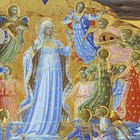
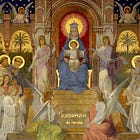
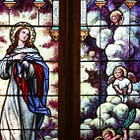
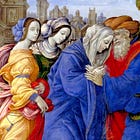

Another treasure from the WM Review, beautifully presented. Thank you.